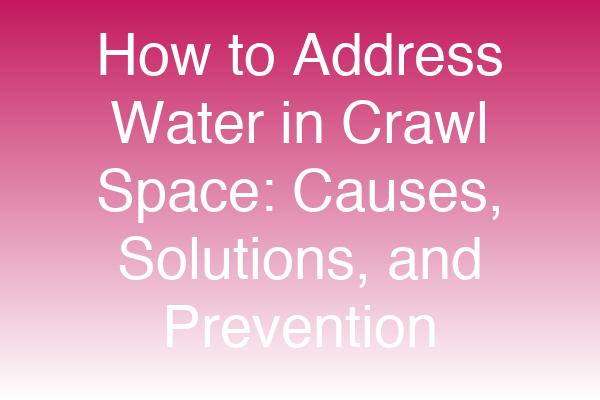
Categories: Home Maintenance, Property Management, DIY Solutions
Tags: water in crawl space, crawl space moisture, home repair, basement flooding, water damage prevention, crawl space solutions, dampness in crawl space
Understanding Water in Crawl Space: Causes and Solutions
Introduction
Water in crawl spaces is a common issue that many homeowners face, yet it often goes unnoticed until significant damage occurs. This problem can lead to structural damage, mold growth, and a host of other issues that can affect your home’s health and safety. In this comprehensive guide, we will explore the causes of water accumulation in crawl spaces, effective solutions, and preventive measures you can take to protect your home.
Why Is Water Accumulating in Your Crawl Space?
Understanding the causes of water in crawl spaces is critical for effective remediation. Here are some common culprits:
- Poor Drainage Systems: Inefficient gutters and downspouts can lead to water pooling around the foundation.
- Groundwater Seepage: High water tables or heavy rainfall can cause groundwater to seep into crawl spaces.
- Leaky Pipes: Broken or leaking plumbing can introduce unwanted moisture.
- Humidity: High humidity levels can lead to condensation in crawl spaces, especially in warmer months.
- Flooding: Heavy storms or flooding can overwhelm drainage systems and lead to water intrusion.
Identifying the Signs of Water in Your Crawl Space
Recognizing the signs of water intrusion early can save you from costly repairs. Look for:
- Damp or Musty Odors: A persistent smell can indicate mold or mildew.
- Visible Water Puddles: Standing water is a clear sign of a problem.
- Mold Growth: Check for mold on beams, insulation, and walls.
- Wood Rot: Soft or decaying wood can indicate prolonged moisture exposure.
- Insect Infestations: Termites and other pests thrive in damp environments.
Solutions for Water in Crawl Space
Once you've identified the problem, it's time to take action. Here are some effective solutions:
1. Improve Drainage
- Gutters and Downspouts: Ensure gutters are clean and downspouts direct water at least 5-10 feet away from the foundation.
- French Drains: Installing a French drain can help redirect water away from the crawl space.
2. Install a Vapor Barrier
A vapor barrier is a thick plastic sheet that covers the ground in your crawl space, preventing moisture from rising. Here’s how to install one:
1. Clean the crawl space floor.
2. Lay down a 6-mil polyethylene sheet, overlapping seams by at least 12 inches.
3. Seal seams with waterproof tape.
4. Extend the barrier up the walls and secure it with adhesive.3. Use a Dehumidifier
Installing a dehumidifier can help control humidity levels in your crawl space, reducing the risk of mold growth.
4. Repair Leaks
Inspect plumbing for leaks and repair any broken pipes promptly to prevent moisture intrusion.
5. Consider a Sump Pump
For areas prone to flooding, a sump pump can be an effective solution to remove water from the crawl space.
Preventive Measures to Keep Your Crawl Space Dry
Preventing water accumulation is just as important as addressing it. Here are some proactive steps:
- Regular Inspections: Check your crawl space regularly for signs of moisture.
- Landscaping: Ensure the ground slopes away from your home’s foundation.
- Insulation: Properly insulate your crawl space to reduce condensation.
- Ventilation: Ensure adequate ventilation to allow moisture to escape.
Expert Insights on Crawl Space Moisture Management
Expert Quote 1: "Regular maintenance and monitoring can prevent most issues related to water in crawl spaces. Homeowners should be proactive rather than reactive." – John Smith, Home Inspector.
Expert Quote 2: "Investing in a good drainage system is crucial for long-term protection against moisture-related problems." – Jane Doe, Structural Engineer.
Conclusion
Water in crawl spaces can lead to severe issues if not addressed promptly. By understanding the causes, identifying the signs, and implementing effective solutions and preventive measures, you can protect your home from the damaging effects of moisture. Don’t wait for the problem to escalate—take action today!
Call-to-Action
If you’re dealing with water in your crawl space, contact us for a comprehensive inspection and tailored solutions to protect your home.
Social Media Snippet
🚨 Is water in your crawl space causing you headaches? Discover effective solutions and prevention tips in our latest blog post! #HomeMaintenance #WaterInCrawlSpace
Suggested Internal Links
- How to Prevent Mold Growth in Your Home
- The Importance of Proper Home Insulation
- Essential Home Maintenance Tips for Every Season
Suggested External Links
- U.S. Environmental Protection Agency on Mold
- National Association of Home Builders: Crawl Space Basics
FAQs
Q1: How can I tell if my crawl space is damp?
A1: Look for signs like musty odors, mold growth, and visible water puddles.
Q2: What is the best way to prevent water in my crawl space?
A2: Improve drainage, install a vapor barrier, and ensure proper ventilation.
Q3: Can I fix water issues in my crawl space myself?
A3: Some minor issues can be DIY, but it's best to consult a professional for significant problems.
Q4: How often should I inspect my crawl space?
A4: Inspect at least twice a year, especially after heavy rains.
Q5: What should I do if I find mold in my crawl space?
A5: Address the moisture source, remove moldy materials, and consider professional remediation.
This comprehensive guide provides valuable insights into managing water in crawl spaces, ensuring your home remains safe and dry.